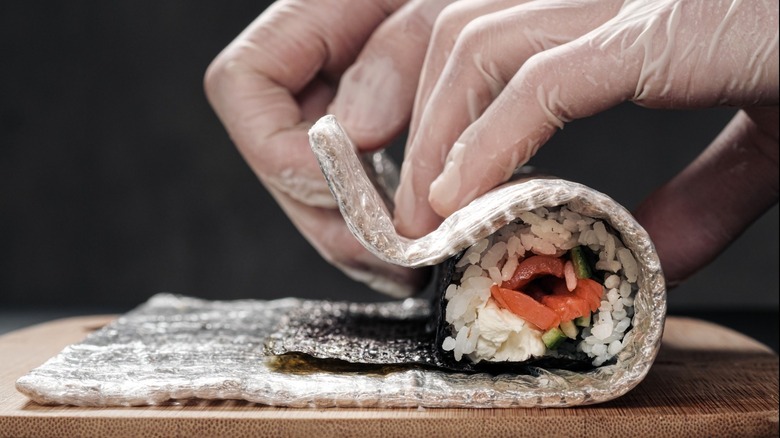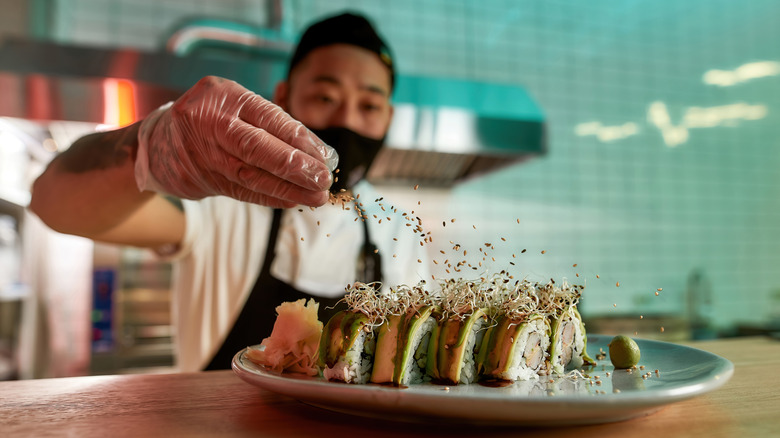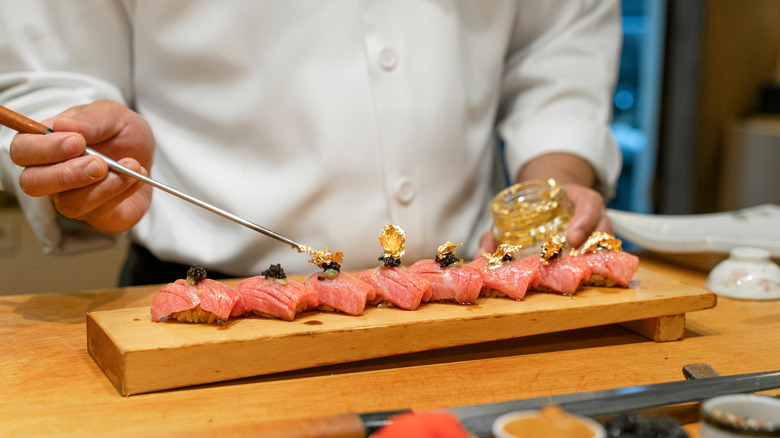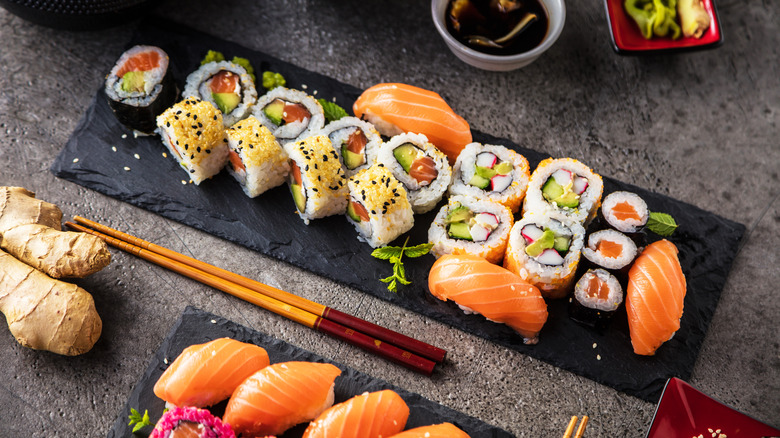How Much Money Do Sushi Chefs Typically Make?
These days, it can feel like there's a sushi restaurant around every corner. Back in 2017, Mental Floss reported that there were approximately 4,000 sushi restaurants around the United States, which would equate to nearly 80 restaurants per state on average, including Washington, D.C. The outlet also noted that sushi is a roughly $2 billion industry in the U.S.
Over the years, sushi has become one of the most consumed cuisines in the U.S., with Google data ranking Japanese dishes the sixth most popular ethnic cuisine in the country, per Chef's Pencil. Popular rolls include the California roll, which typically contains imitation crab, cucumber, and avocado, as well as the spicy tuna roll, which is filled with a combination of raw tuna and spicy sauce.
According to a study published by Taylor & Francis Online, sushi consumption became fairly widespread in the U.S. back in the 1960s, but it first started growing in popularity at the end of World War II. Today, with the sushi industry worth so much money, we can't help but ask: How much does a typical sushi chef get paid? It turns out the numbers vary greatly depending on where you live.
The average sushi chef makes $38,000 per year
If you're interested in becoming a sushi chef, you might want to consider a move to Hawaii or New Jersey. These are the two states in which sushi chefs make the most money, according to data from Zippia — and they beat the other states' salaries by a landslide.
Zippia reports that the national average for a sushi chef salary is around $38,000. In Hawaii and New Jersey, it's at least double that, with Hawaii's average salary coming in around $78,000 and New Jersey's right behind it at $76,000. California takes the third-place spot, but with a substantial drop; its average salary is about $59,000. Four states have average salaries that fall under $30,000: Tennessee and Kansas, which both average a little more than $29,000, as well as Idaho at about $28,000, and Wyoming at about $21,000.
ZipRecruiter posted similar data about sushi chef salaries, with their average annual rate nationwide landing just over $37,000 and their hourly rate averaging just under $18. ZipRecruiter also reports that New Jersey, Hawaii, and California actually don't have very active sushi chef job markets at the time of this writing.
Some sushi chefs have intense training
Despite the average sushi chef salary being nearly $10,000 below the U.S. national average for any industry, it can be years before someone has the proper training and skill set to become a head sushi chef. According to Australian website Kobe Jones, sushi chefs must have incomparable knife skills, which can take time to properly learn. Plus, they must be able to appropriately clean the fish, since sushi is primarily made with raw fish that, if improperly handled, could expose the consumer to foodborne illness.
In Japan, the head sushi chef is known as an Itamae, and the Itamae often has an apprentice beneath him, known as a Wakiita. According to Outsider Japan, the Wakiita could train under the Itamae for up to a decade before possessing the skill set required to become the Itamae.
Kobe Jones reiterates the length of training, adding that the role of head sushi chef is considered an honor in Japan and is not for the faint of heart. However, the outlet reports that there are certification programs that allow someone to gain the skill set to become a sushi chef in less time. Still, Kobe Jones stresses the necessity of working in a sushi kitchen in some capacity before becoming a head chef versus only completing a sushi training program.
Sushi chefs typically learn six types of sushi
In addition to knife skills and sanitary preparation, sushi chefs often master six different types of sushi. The first is nigiri, which, according to Spoon University, is traditionally made by pressing thin slices of raw fish over rice. Sake, which is salmon, and ahi, which is tuna, are common types of nigiri. Next is sashimi, which is just thin slices of raw fish, sans rice. Maki, another sushi type, consists of seaweed on the outside, rice inside of that, and a filling that can be various ingredients.
When you think of sushi in its most common form in the U.S., you might think of uramaki, which is essentially maki with the rice and seaweed reversed: The rice is on the outside, and the seaweed is on the inside, with the fish or veggies still in the center. Temaki is another form of rolled sushi, but the main distinction between temaki versus maki and uramaki is that it is rolled by hand instead of with bamboo mats. Spoon University reports that hand-rolling the temaki gives it more of a cone shape, as well as a much larger size. Those expecting six rolls of temaki should know that it's more common to only receive one large roll.
Finally, the sixth form of sushi is the tempura roll — also known as a fried sushi roll. The rolls, which are usually prepared in the form of maki or uramaki rolls, are fried in a tempura batter, so their internal contents are fully cooked.



